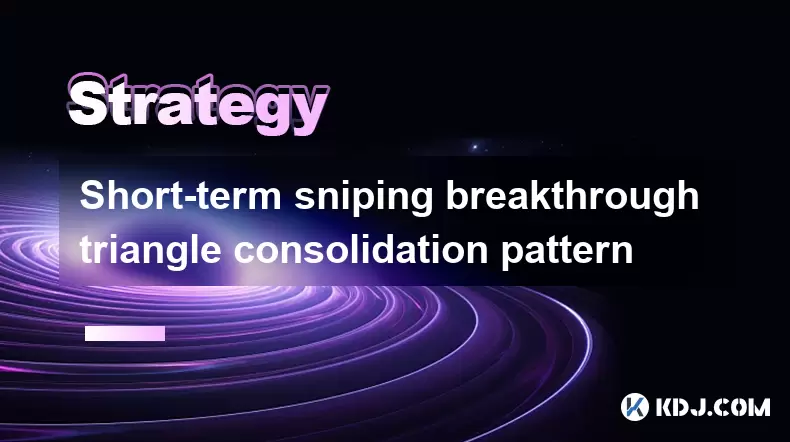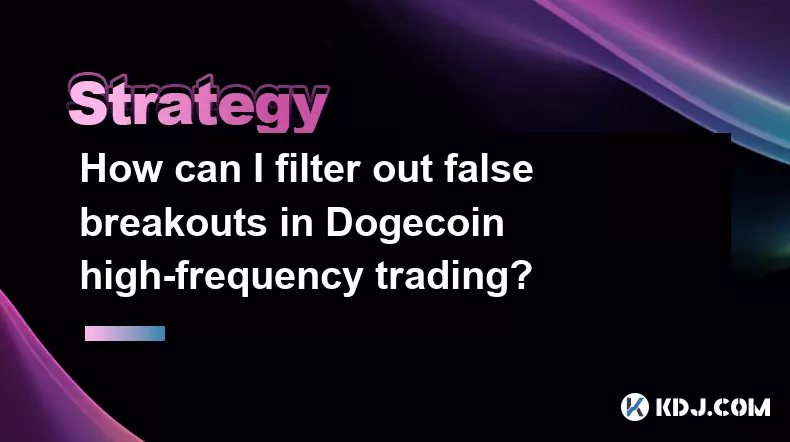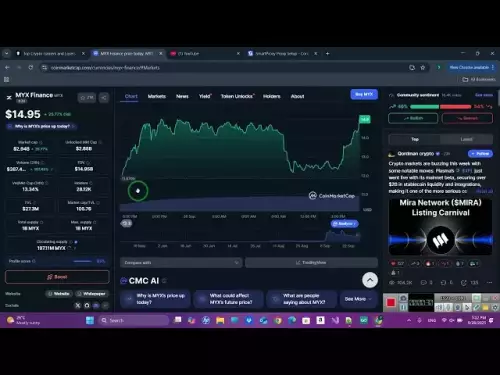-
 bitcoin
bitcoin $109547.008142 USD
0.04% -
 ethereum
ethereum $4011.838726 USD
-0.05% -
 tether
tether $1.000402 USD
-0.01% -
 xrp
xrp $2.798606 USD
0.88% -
 bnb
bnb $970.877944 USD
1.39% -
 solana
solana $202.237275 USD
-0.95% -
 usd-coin
usd-coin $0.999673 USD
0.00% -
 dogecoin
dogecoin $0.229294 USD
-1.15% -
 tron
tron $0.336370 USD
-0.45% -
 cardano
cardano $0.777260 USD
-1.66% -
 hyperliquid
hyperliquid $45.503019 USD
1.73% -
 ethena-usde
ethena-usde $1.000362 USD
0.01% -
 chainlink
chainlink $20.785303 USD
-1.10% -
 avalanche
avalanche $28.755822 USD
-0.11% -
 stellar
stellar $0.358303 USD
-0.48%
Short-term sniping breakthrough triangle consolidation pattern
Short-term sniping can exploit triangle breakouts for quick gains; use RSI and MACD to confirm momentum and set tight stop losses for risk management.
Jun 07, 2025 at 02:21 pm

Short-term sniping, often referred to as scalping in the cryptocurrency trading world, involves making quick trades to profit from small price movements. When combined with a technical analysis pattern such as the triangle consolidation, it can potentially increase the likelihood of a successful trade. In this article, we'll delve into how traders can identify and exploit a breakout from a triangle consolidation pattern for short-term gains.
Understanding Triangle Consolidation Patterns
A triangle consolidation pattern is a technical analysis chart pattern that forms as the range between highs and lows narrows, creating a triangle shape. This pattern signals that the market is consolidating and preparing for a potential breakout. There are three main types of triangle patterns: ascending, descending, and symmetrical. Each type can indicate different market sentiments and potential breakout directions.
In an ascending triangle, the upper trendline is horizontal while the lower trendline slopes upwards. This pattern typically suggests bullish sentiment as buyers are willing to buy at higher lows, but sellers are not allowing the price to break above a certain resistance level.
A descending triangle features a horizontal lower trendline and a downward-sloping upper trendline. This pattern indicates bearish sentiment, with sellers pushing the price down to lower highs, but buyers are holding the price above a certain support level.
A symmetrical triangle has both trendlines converging towards each other, with the upper trendline sloping downwards and the lower trendline sloping upwards. This pattern suggests that the market is in a state of equilibrium and could break out in either direction.
Identifying a Breakout from a Triangle Consolidation
Identifying a breakout from a triangle consolidation pattern involves watching for a decisive move above the upper trendline or below the lower trendline. Traders should look for increased volume as the price breaks out, which can confirm the validity of the breakout.
To identify a breakout, follow these steps:
- Monitor the price action as it approaches the apex of the triangle.
- Watch for a candle that closes decisively outside the triangle's boundaries.
- Confirm the breakout with higher-than-average trading volume.
- Set a target for the potential move based on the height of the triangle at its widest point, added to or subtracted from the breakout point.
Short-term Sniping Strategies for Triangle Breakouts
Short-term sniping strategies for triangle breakouts involve entering a trade shortly after the breakout and exiting quickly to capture small profits. Here are some strategies traders might employ:
- Quick Entry and Exit: Enter the trade as soon as the breakout is confirmed and exit as soon as a small profit target is reached or if the price shows signs of reversing back into the triangle.
- Using Stop Losses: Place a tight stop loss just inside the triangle's boundary to minimize potential losses if the breakout fails.
- Leveraging Technical Indicators: Use indicators like the Relative Strength Index (RSI) or Moving Average Convergence Divergence (MACD) to confirm the strength of the breakout and the momentum of the move.
Risk Management in Short-term Sniping
Risk management is crucial in short-term sniping, especially when trading breakouts from triangle consolidations. Traders should consider the following risk management techniques:
- Position Sizing: Only risk a small percentage of your trading capital on each trade to ensure that a series of losses won't significantly impact your overall portfolio.
- Stop Loss Orders: Always use stop loss orders to limit potential losses. For a triangle breakout, set the stop loss just inside the triangle's boundary.
- Profit Targets: Set realistic profit targets based on the height of the triangle and the average volatility of the cryptocurrency being traded.
Practical Example of Short-term Sniping a Triangle Breakout
Let's walk through a practical example of short-term sniping a triangle breakout using Bitcoin (BTC).
- Identify the Pattern: You notice that BTC has been forming an ascending triangle over the past few weeks, with a horizontal resistance at $40,000 and higher lows approaching the resistance.
- Monitor for Breakout: You keep a close eye on the price action as it nears the apex of the triangle. You see a candle close decisively above $40,000 with significantly higher volume than the average.
- Enter the Trade: You enter a long position immediately after the breakout is confirmed, setting a tight stop loss at $39,900, just below the breakout point.
- Set Profit Target: Based on the height of the triangle at its widest point ($2,000), you set a profit target at $42,000 ($40,000 + $2,000).
- Exit the Trade: The price quickly moves to $40,500, and you decide to take a small profit of $500 per BTC, exiting the trade to capture the gain.
Technical Indicators to Enhance Sniping
Using technical indicators can enhance the effectiveness of short-term sniping strategies. Here are some indicators that traders might find useful:
- Relative Strength Index (RSI): The RSI can help traders identify overbought or oversold conditions, which can signal potential reversals or continuations of the breakout.
- Moving Average Convergence Divergence (MACD): The MACD can confirm the momentum of the breakout. A bullish crossover of the MACD line above the signal line can confirm a bullish breakout, while a bearish crossover can confirm a bearish breakout.
- Bollinger Bands: Bollinger Bands can help traders identify volatility and potential breakout points. A price move outside the bands can signal a strong breakout.
Frequently Asked Questions
Q: How can I improve my timing when sniping a triangle breakout?A: Improving timing when sniping a triangle breakout involves closely monitoring the price action and volume as the price approaches the apex of the triangle. Using technical indicators like the RSI and MACD can also help confirm the strength of the breakout. Practice and experience will enhance your ability to time your entries and exits more effectively.
Q: What are the most common mistakes traders make when sniping triangle breakouts?A: Common mistakes include entering trades too early before a breakout is confirmed, setting stop losses too far away, and not exiting trades quickly enough to capture small profits. Traders may also fail to consider the overall market context and the impact of news events on cryptocurrency prices.
Q: Can short-term sniping be profitable for all types of traders?A: Short-term sniping can be profitable for traders who are disciplined, have a solid understanding of technical analysis, and are willing to manage their risk effectively. However, it may not be suitable for all traders, especially those who prefer longer-term investment strategies or have a lower risk tolerance.
Q: How do I choose the right cryptocurrency for short-term sniping?A: Choosing the right cryptocurrency involves considering factors such as liquidity, volatility, and trading volume. Cryptocurrencies with high liquidity and volatility are often preferred for short-term sniping because they offer more trading opportunities and the potential for quick profits. Additionally, staying informed about market trends and news can help identify cryptocurrencies with potential breakout opportunities.
Disclaimer:info@kdj.com
The information provided is not trading advice. kdj.com does not assume any responsibility for any investments made based on the information provided in this article. Cryptocurrencies are highly volatile and it is highly recommended that you invest with caution after thorough research!
If you believe that the content used on this website infringes your copyright, please contact us immediately (info@kdj.com) and we will delete it promptly.
- Cheap AI Coding Revolution: Gemini 2.5 and the 1 Million Token Dream
- 2025-09-28 20:25:16
- Tether, Circle, and Competition: A Stablecoin Showdown in 2025
- 2025-09-28 20:25:16
- Layer Brett vs. Cardano: A Price Prediction Face-Off for 2025
- 2025-09-28 20:30:03
- Crypto Presale Alert: Unveiling the 500x Potential New Coins of 2025
- 2025-09-28 20:30:03
- Bitcoin Volatility, Whales, and Market Stir: What's the Deal?
- 2025-09-28 20:30:03
- XRP, Ripple, Price Prediction: Decoding the Crypto Crystal Ball
- 2025-09-28 21:05:12
Related knowledge

Practical parameter settings for a Bitcoin multi-timeframe moving average system
Sep 18,2025 at 10:54pm
Optimizing Timeframe Combinations for Bitcoin Trading1. Selecting appropriate timeframes is crucial when building a multi-timeframe moving average sys...

How can I filter out false breakouts in Dogecoin high-frequency trading?
Sep 22,2025 at 01:00am
Understanding False Breakouts in Dogecoin Trading1. A false breakout occurs when Dogecoin's price appears to move beyond a defined support or resistan...

Techniques for identifying tops and bottoms in the Bitcoin on-chain NVT model
Sep 20,2025 at 07:54pm
Understanding the NVT Model in Bitcoin Analysis1. The Network Value to Transactions (NVT) ratio is often described as the 'P/E ratio' of the cryptocur...

What does the surge in open interest in Bitcoincoin futures mean?
Sep 20,2025 at 11:18pm
Understanding the Surge in Dogecoin Futures Open Interest1. A surge in open interest within Dogecoin futures indicates a growing number of active cont...

How can I use the Ethereum USDT premium to gauge market sentiment?
Sep 18,2025 at 11:55pm
Understanding the Ethereum USDT Premium1. The Ethereum USDT premium refers to the price difference between USDT (Tether) traded on Ethereum-based plat...

What should I do if Ethereum staking yields decline?
Sep 20,2025 at 06:18am
Understanding the Causes Behind Declining Ethereum Staking Yields1. The Ethereum network transitioned to a proof-of-stake consensus mechanism with the...

Practical parameter settings for a Bitcoin multi-timeframe moving average system
Sep 18,2025 at 10:54pm
Optimizing Timeframe Combinations for Bitcoin Trading1. Selecting appropriate timeframes is crucial when building a multi-timeframe moving average sys...

How can I filter out false breakouts in Dogecoin high-frequency trading?
Sep 22,2025 at 01:00am
Understanding False Breakouts in Dogecoin Trading1. A false breakout occurs when Dogecoin's price appears to move beyond a defined support or resistan...

Techniques for identifying tops and bottoms in the Bitcoin on-chain NVT model
Sep 20,2025 at 07:54pm
Understanding the NVT Model in Bitcoin Analysis1. The Network Value to Transactions (NVT) ratio is often described as the 'P/E ratio' of the cryptocur...

What does the surge in open interest in Bitcoincoin futures mean?
Sep 20,2025 at 11:18pm
Understanding the Surge in Dogecoin Futures Open Interest1. A surge in open interest within Dogecoin futures indicates a growing number of active cont...

How can I use the Ethereum USDT premium to gauge market sentiment?
Sep 18,2025 at 11:55pm
Understanding the Ethereum USDT Premium1. The Ethereum USDT premium refers to the price difference between USDT (Tether) traded on Ethereum-based plat...

What should I do if Ethereum staking yields decline?
Sep 20,2025 at 06:18am
Understanding the Causes Behind Declining Ethereum Staking Yields1. The Ethereum network transitioned to a proof-of-stake consensus mechanism with the...
See all articles









































































